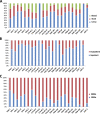Analysis of β-lactamase phenotypes and carriage of selected β-lactamase genes among Escherichia coli strains obtained from Kenyan patients during an 18-year period
- PMID: 22838634
- PMCID: PMC3464591
- DOI: 10.1186/1471-2180-12-155
Analysis of β-lactamase phenotypes and carriage of selected β-lactamase genes among Escherichia coli strains obtained from Kenyan patients during an 18-year period
Abstract
Background: Although β-lactam antibiotics are heavily used in many developing countries, the diversity of β-lactamase genes (bla) is poorly understood. We screened for major β-lactamase phenotypes and diversity of bla genes among 912 E. coli strains isolated from clinical samples obtained between 1992 and 2010 from hospitalized and non-hospitalized patients.
Results: None of the isolates was resistant to carbapenems but 30% of all isolates were susceptible to cefepime, cephamycins and piperacillin-tazobactam. Narrow spectrum β-lactamase (NSBL) phenotype was observed in 278 (30%) isolates that contained bla(TEM-1) (54%) or bla(SHV-1) (35%) or both (11%). Extended Spectrum β-lactamase (ESBL) phenotype was detected in 247 (27%) isolates which carried blaCTX-M-14 (29%), bla(CTX-M-15) (24%), bla(CTX-M-9) (2%), bla(CTX-M-8) (4%), bla(CTX-M-3) (11%), bla(CTX-M-1) (6%), blaSHV-5 (3%), bla(SHV-12) (5%), and bla(TEM-52) (16%). Complex Mutant TEM-like (CMT) phenotype was detected in 220 (24%) isolates which carried bla(TEM-125) (29%), while bla(TEM-50), bla(TEM-78), bla(TEM-109), bla(TEM -152) and bla(TEM-158) were detected in lower frequencies of between 7% and 11%. Majority of isolates producing a combination of CTX-M-15 + OXA-1 + TEM-1 exhibited resistance phenotypes barely indistinguishable from those of CMT-producers. Although 73 (8%) isolates exhibited Inhibitor Resistant TEM-like (IRT) phenotype, bla(TEM-103) was the only true IRT-encoding gene identified in 18 (25%) of strains with this phenotype while the rest produced a combination of TEM-1 + OXA-1. The pAmpCs-like phenotype was observed in 94 (10%) isolates of which 77 (82%) carried bla(CMY-2) while 18% contained blaCMY-1.Isolates from urine accounted for 53%, 53%, 74% and 72% of strains exhibiting complex phenotypes such as IRT, ESBL, CMT or pAmpC respectively. On the contrary, 55% isolates from stool exhibited the relatively more susceptible NSBL-like phenotype. All the phenotypes, and majority of the bla genes, were detected both in isolates from hospitalized and non-hospitalized patients but complex phenotypes were particularly common among strains obtained between 2000 and 2010 from urine of hospitalized patients.
Conclusions: The phenotypes and diversity of bla genes in E. coli strains implicated in clinical infections in non-hospitalized and hospitalized patients in Kenya is worryingly high. In order to preserve the efficacy of β-lactam antibiotics, culture and susceptibility data should guide therapy and surveillance studies for β-lactamase-producers in developing countries should be launched.
Figures

References
-
- Huang SS, Lee MH, Leu HS. Bacteremia due to extended-spectrum beta-lactamase-producing Enterobacteriaceae other than Escherichia coli and Klebsiella. J Microbiol Immunol Infect. 2006;39:496–502. - PubMed
-
- Bush K. New beta-lactamases in gram-negative bacteria: diversity and impact on the selection of antimicrobial therapy. Clin Infect Dis. 2001;32:1085–1089. - PubMed
-
- Canton R, Coque TM. The CTX-M beta-lactamase pandemic. Curr Opin Microbiol. 2006;9:466–475. - PubMed
-
- Canton R, Morosini MI, de la Maza OM, de la Pedrosa EG. IRT and CMT beta-lactamases and inhibitor resistance. Clin Microbiol Infect. 2008;14(Suppl 1):53–62. - PubMed
Publication types
MeSH terms
Substances
LinkOut - more resources
Full Text Sources
Medical
Miscellaneous

